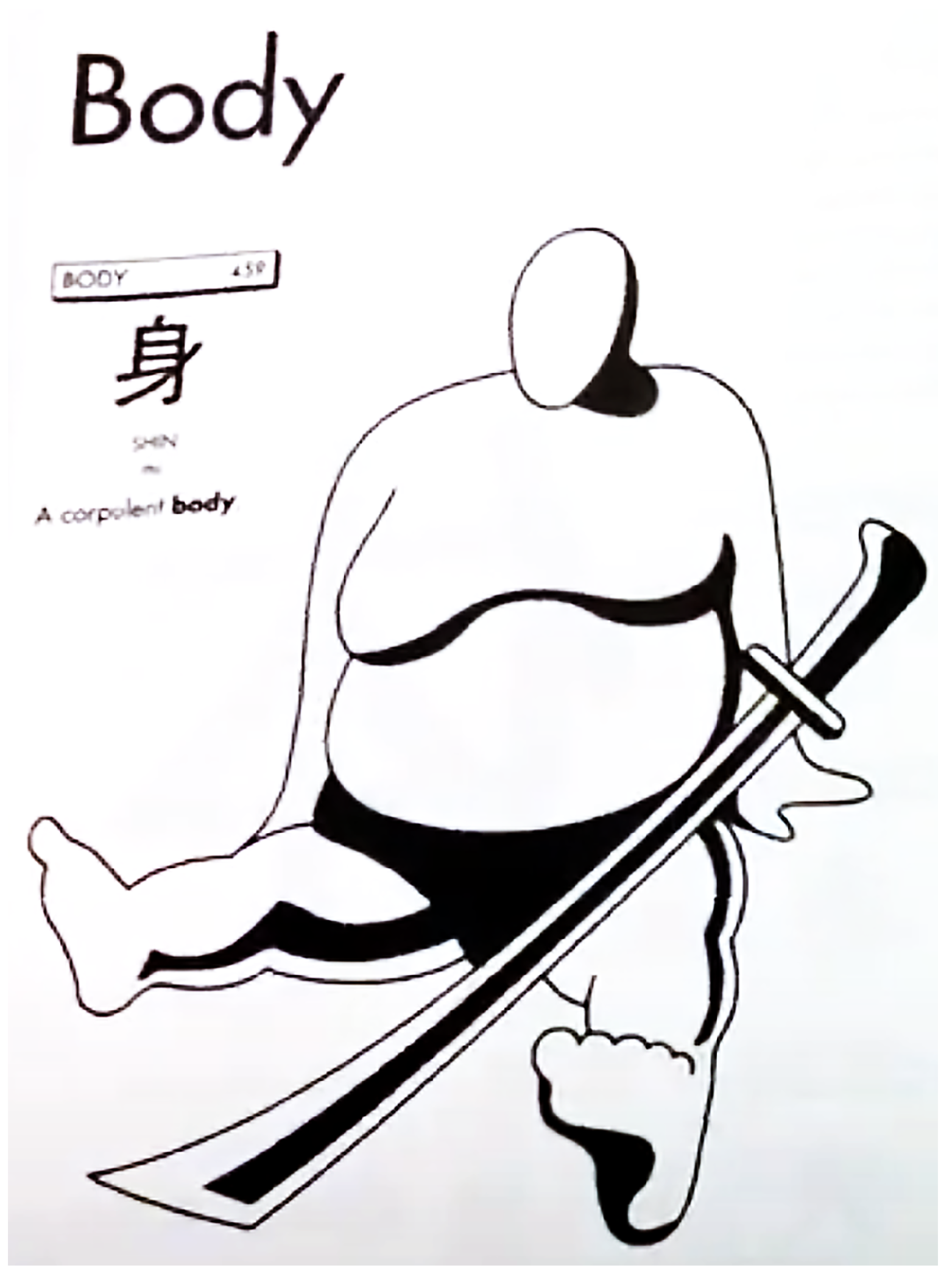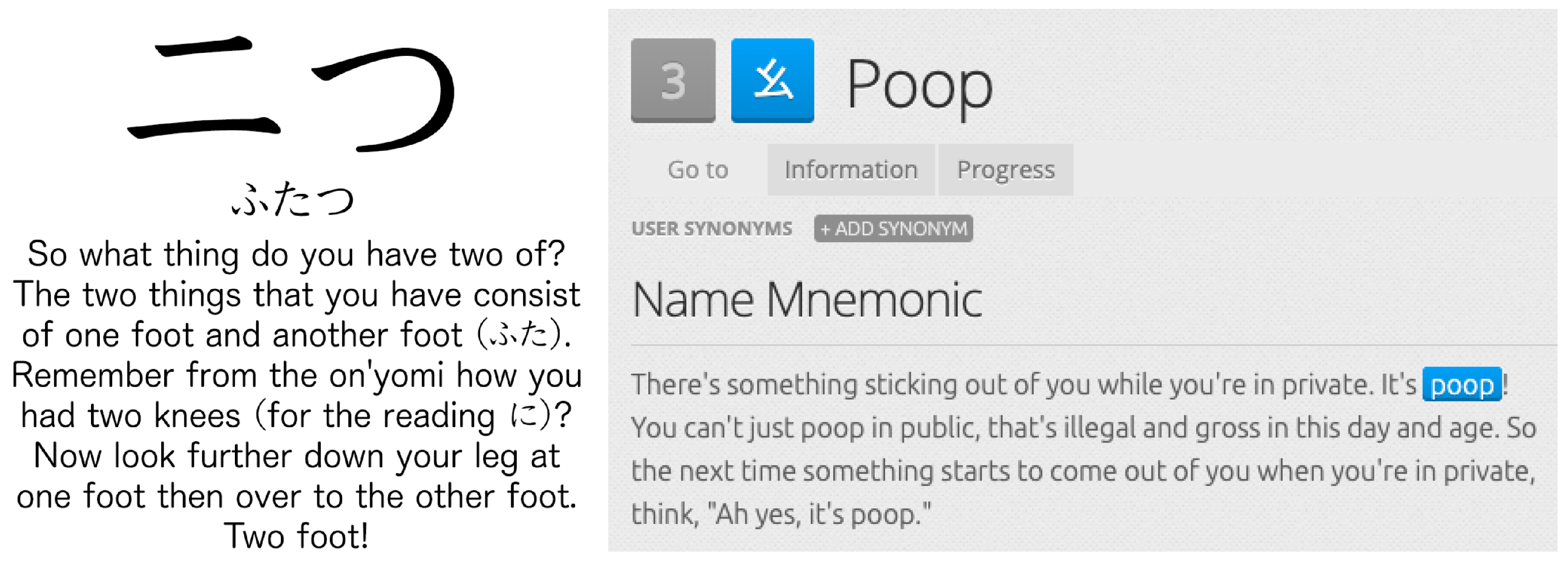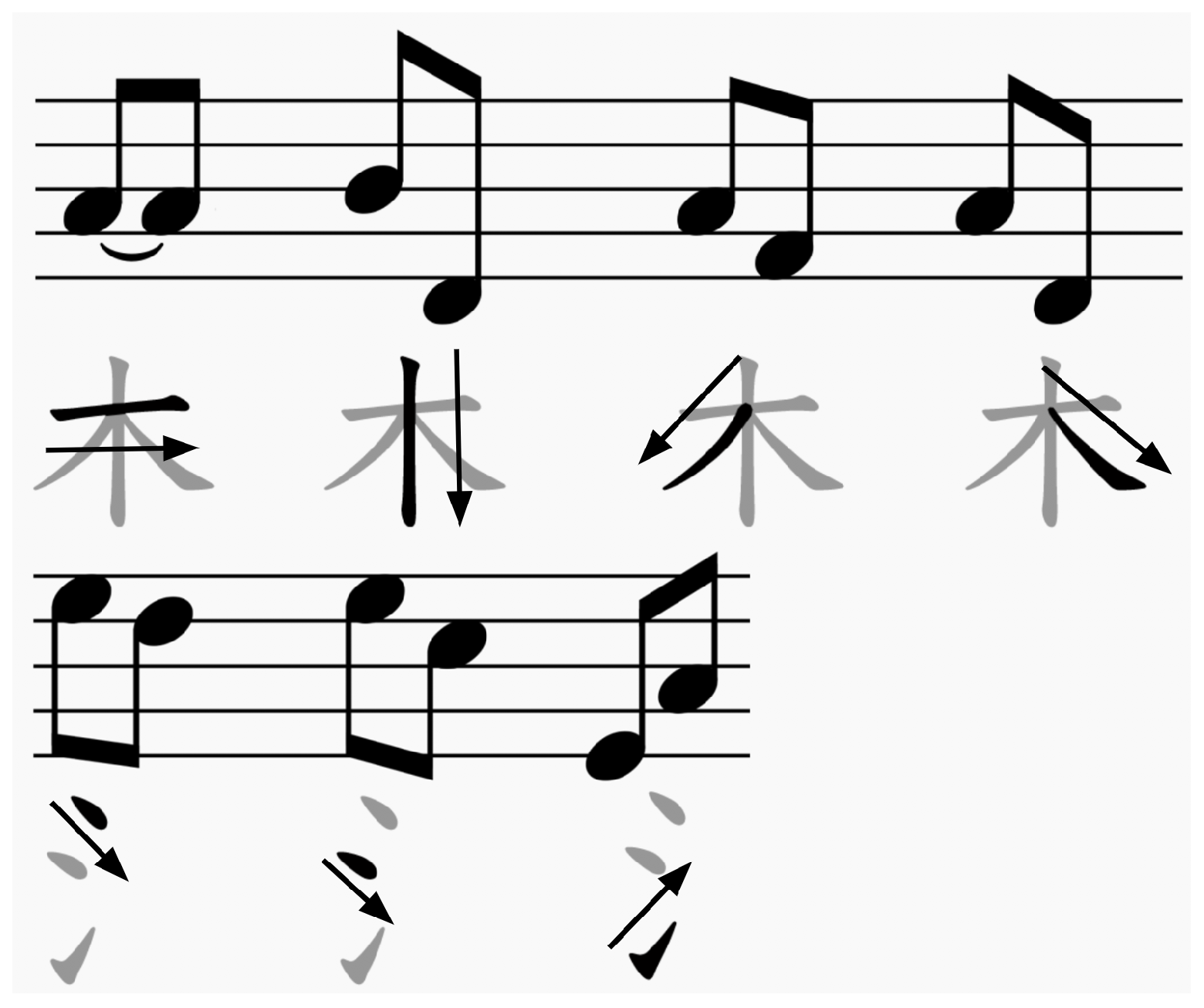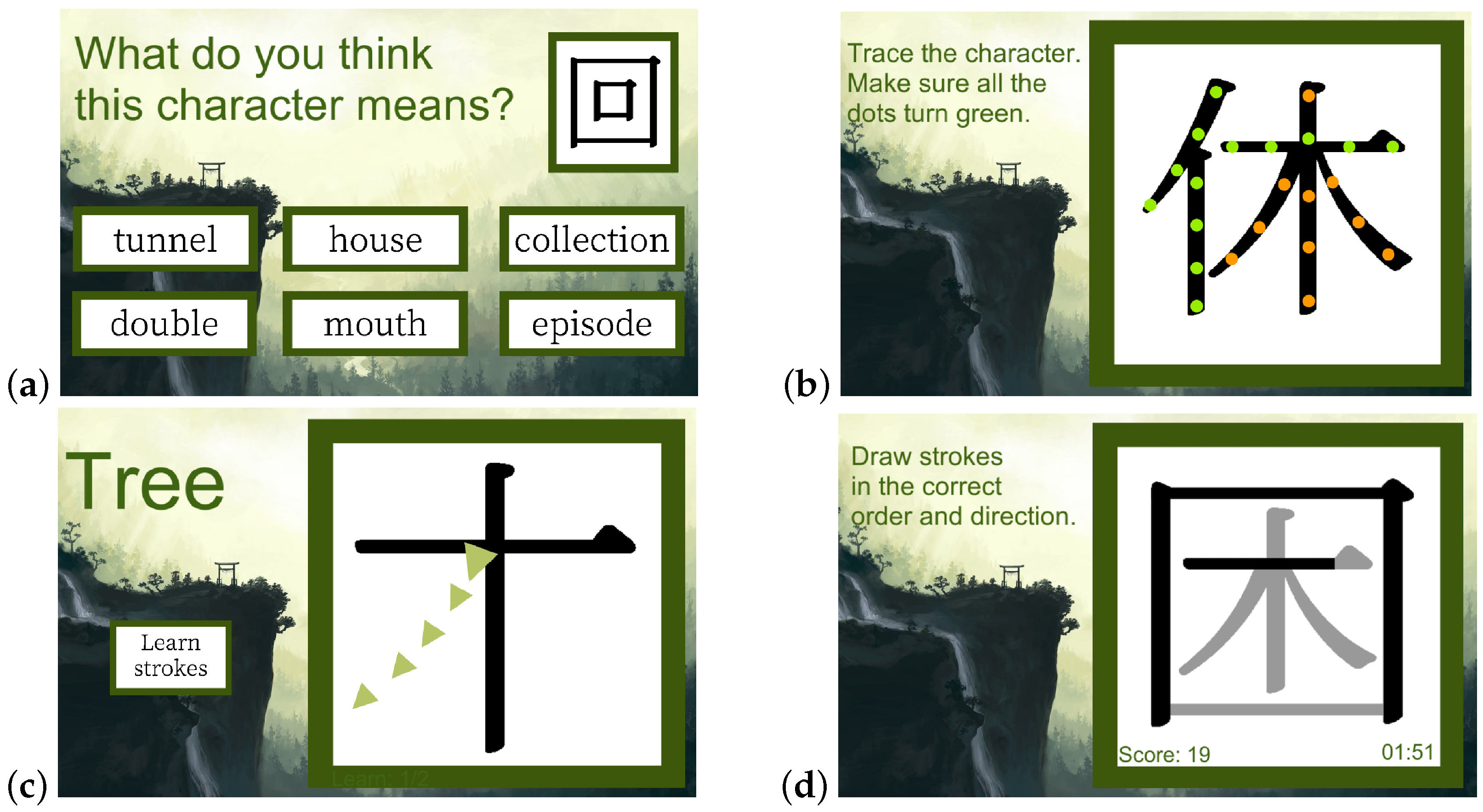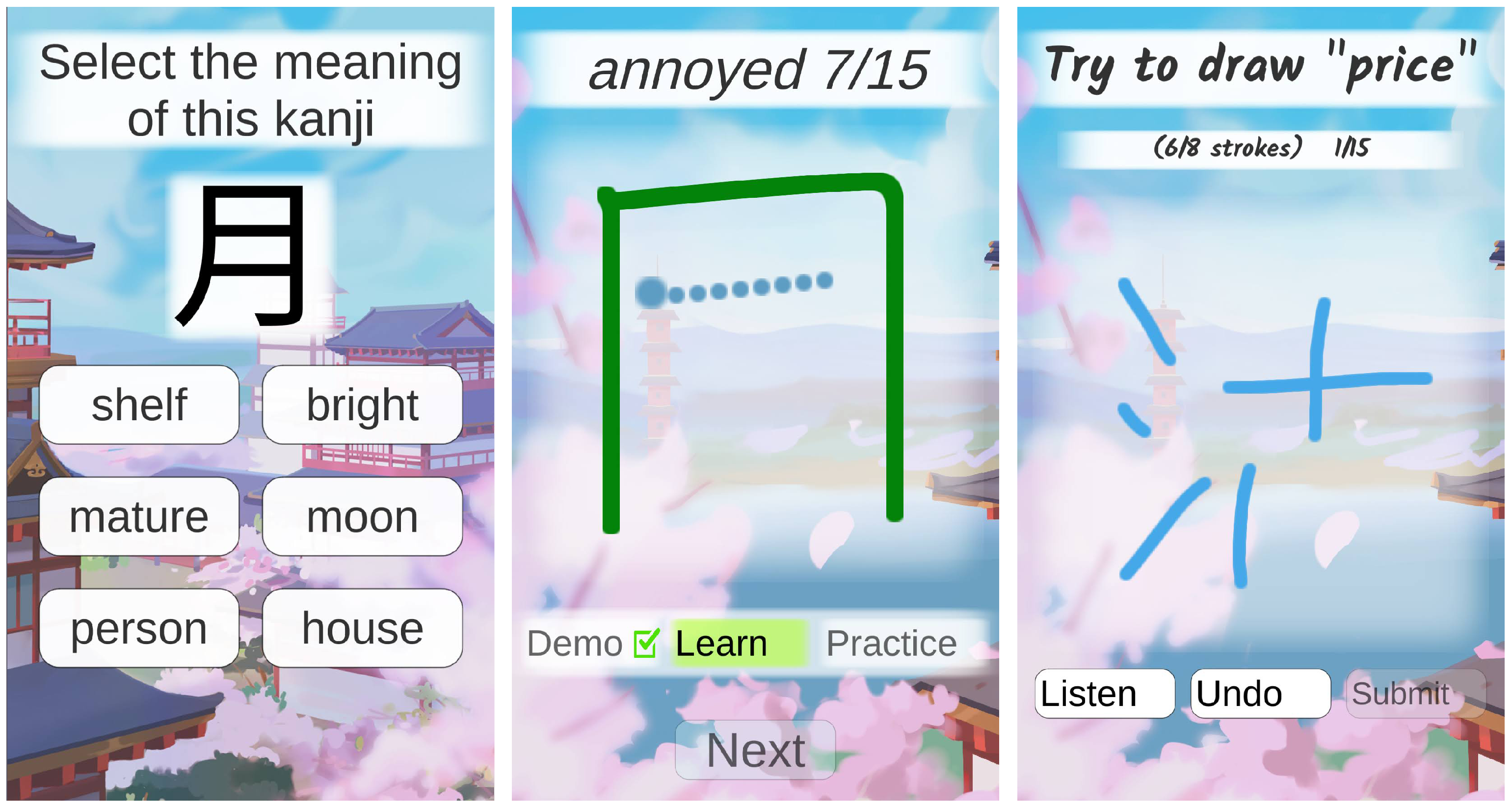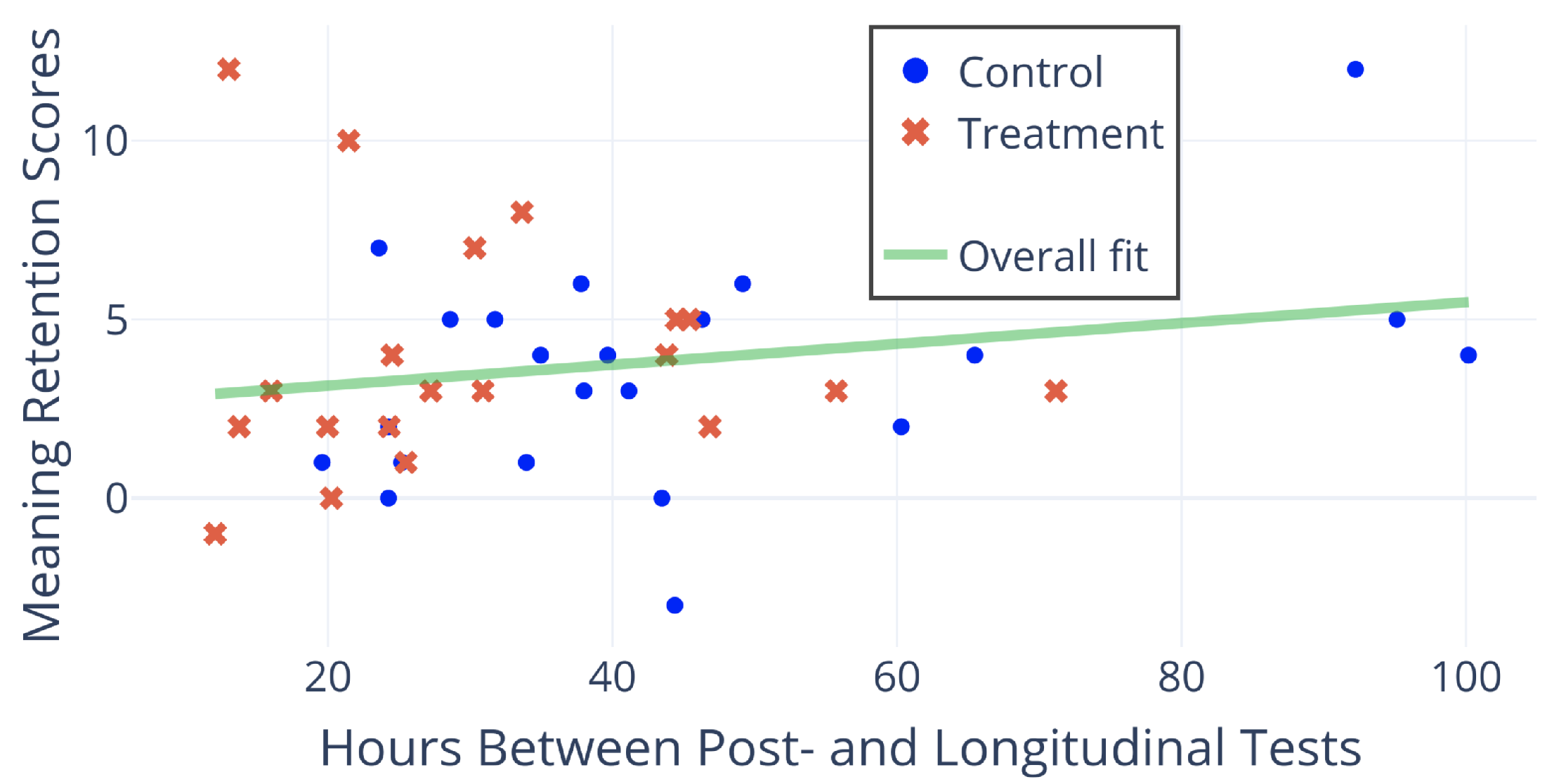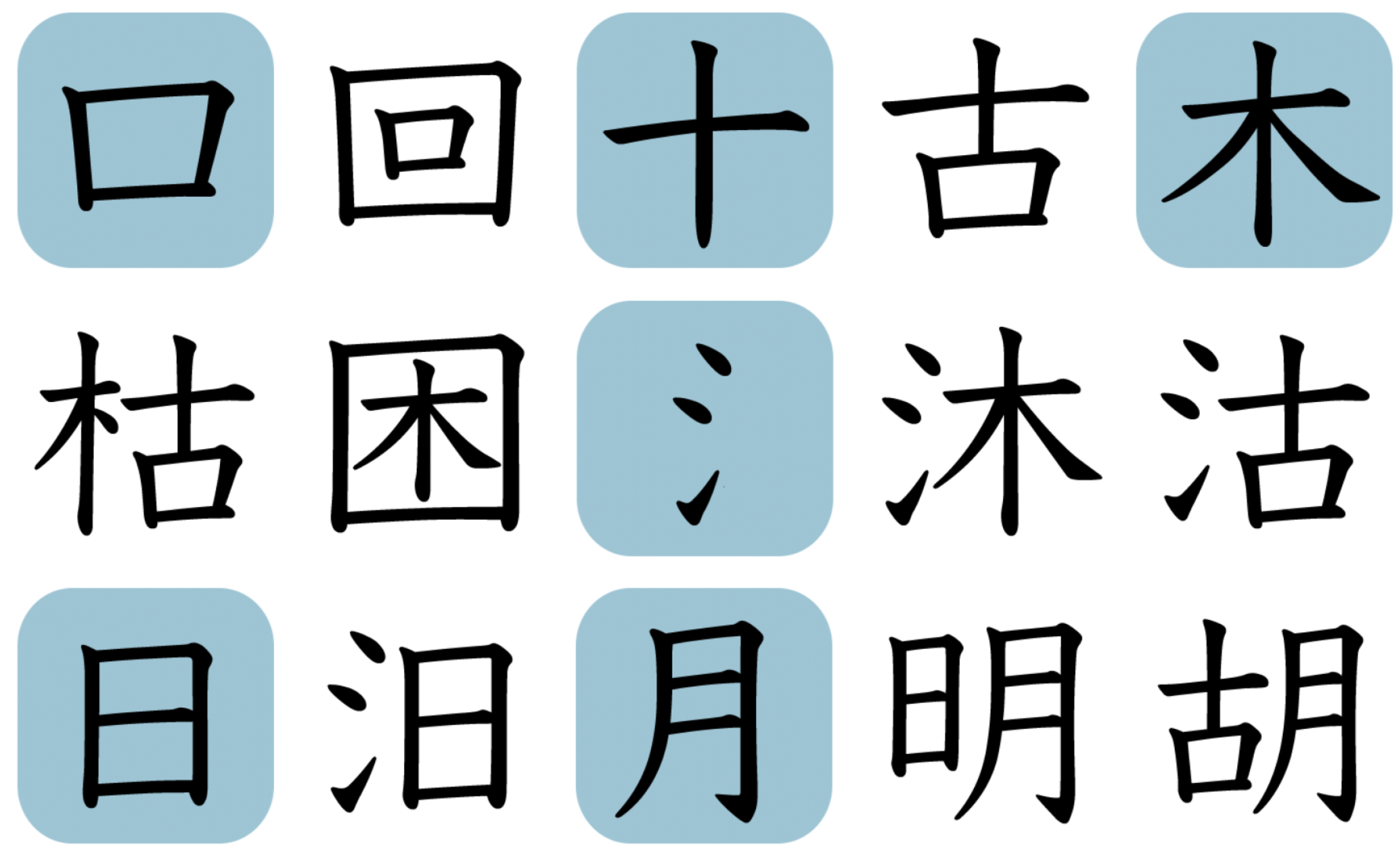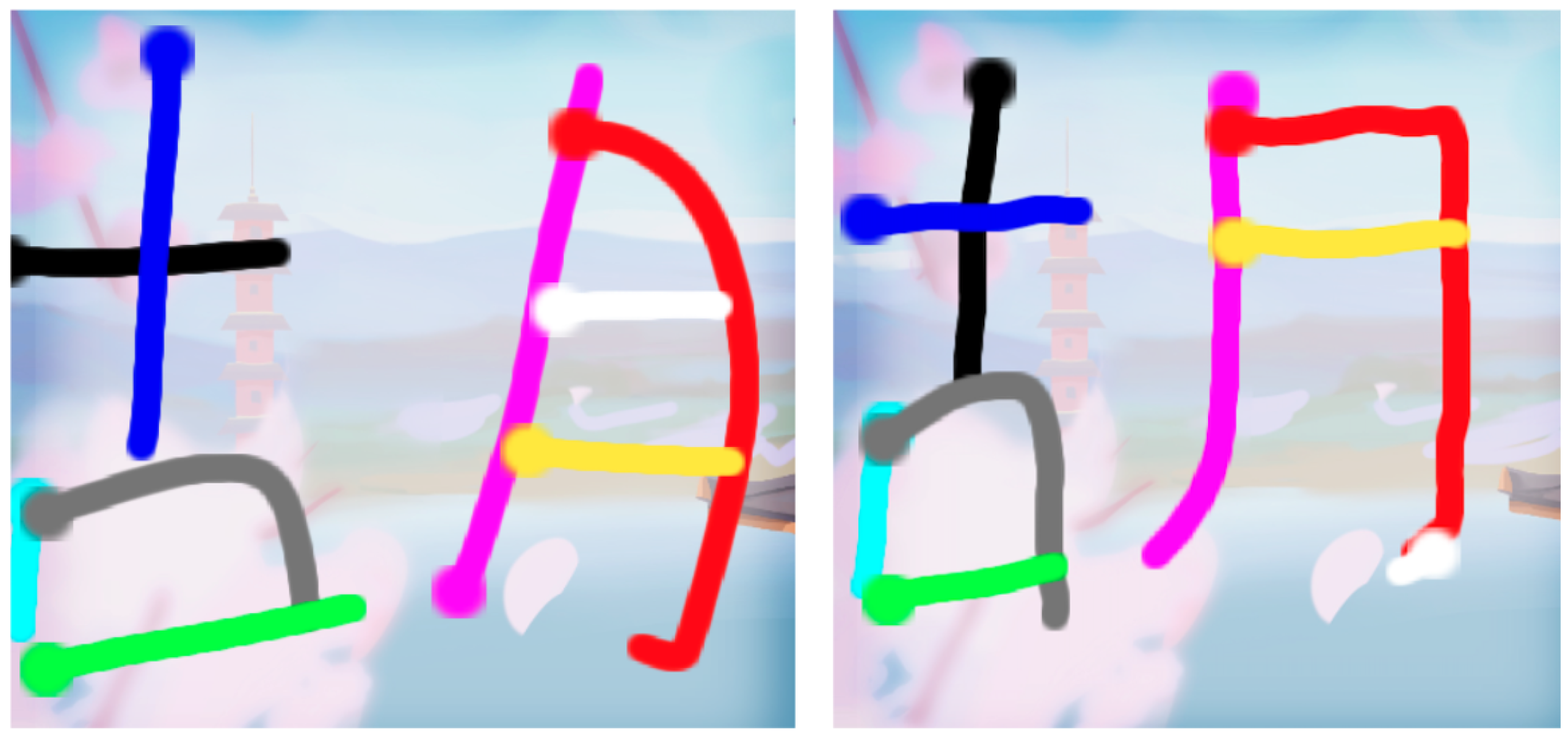1. Introduction
People have many reasons to want to learn a foreign language: some want to enjoy foreign media in its original form, some need it for business or travel, some for personal enrichment, etc. Roughly 1/6 of Earth’s population learn languages with logographic writing systems (LWSs) such as Chinese, Japanese and Korean as their native tongues [
1]. These people harbor enormous cultural, economic and academic wealth. As a result, these languages are a popular choice for a variety of learners ranging from serious businessmen to K-pop and anime fans. Whatever the motivation, learning additional languages carries a slew of cognitive benefits and should be encouraged [
2].
Maintaining the motivation and persistence needed to learn a language is a difficult task, and the problem is amplified for learners with alphabetic roots tackling an LWS language [
3]. One needs to memorize over 2000 characters to be considered literate in their target language [
4]. This is routinely achieved through rote memorization, and this prospect discourages many would-be learners. When it comes to LWS as a foreign language, there is a divide between conversational fluency and literacy unlike that in any alphabetic language [
3]. Our research aims to help bridge this gap through the development and evaluation of LWS learning games.
In recent years and with some success, many aspiring polyglots are turning to mobile apps to help them overcome this hurdle [
5,
6]. The advantages are clear: digital media allows for instant feedback, gamification, inclusion of engaging graphics, audio and video and even finger-writing practice anytime and anywhere [
5]. Many mnemonic devices have been invented to help students remember the meaning, pronunciation and shape of characters (see
Figure 1 and
Figure 2). However, in addition to the characters’ complex designs, there is also a correct order and direction to each stroke within the character. To our knowledge, beyond several rules of thumb fraught with exceptions, no one has created mnemonic devices for remembering the correct stroke order and direction (a.k.a. stroke knowledge). Research suggests that stroke knowledge is positively correlated with obtaining reading and writing fluency, especially in the early stages of learning logographic scripts [
7,
8].
This lack of stroke knowledge mnemonics is something we seek to change. Music has been shown to be a powerful mnemonic device for memorizing text sequences [
10]. One does not have to look far to find the examples, such as the ABC or the 50 states songs. Could melody be used to memorize a sequence of strokes?
To address these issues and the above question, we developed an educational kanji-writing musical game. We named our game Radical Tunes [
11], since its core idea is adding mnemonic melodies, or tunes, to radicals, the building blocks of kanji (see
Figure 3). We hope that by adding the musical elements to the game we can turn the monotonous task of writing kanji over and over into an enjoyable and educationally effective activity. To this end, we are counting on the mnemonic properties of music [
10] and the popularity of music games—such as Osu, which boasts more than 15 million registered players (
https://osu.ppy.sh/home, accessed 9 November 2021). We hypothesized that if each stroke in a character had a specific melodic element assigned to it, the sequence of strokes within a character would give it a unique melodic signature, which might help students with their stroke knowledge acquisition and retention.
Beyond its mnemonic potential and aesthetic appeal, music has also been shown to notably alter immersion [
12,
13]. Cairns et al. [
14] describe immersion as “the degree of involvement that players have with different aspects of the game leading to a move of the attention, awareness and thoughts of the player from the real world around them to the events happening within the game”. This suggests that immersion is an important part of the gaming experience. Other research shows that it can positively influence learning in several ways [
15,
16], making it important for educational games in general. Therefore, we also hypothesized that incorporating music into the design of Radical Tunes would improve its immersion as well.
In this article, we provide the design rationale for Radical Tunes—which ties mnemonic melodies to radicals within kanji [
11]. We describe two experimental studies exploring melody’s effect on the engagement, immersion and learning of LWS. Our studies showed that music in Radical Tunes enhanced player/learner immersion. We also found that there was a positive correlation between melody presence and character production, particularly for more complex characters.
The contributions of this work are as follows:
A novel mnemonic design for acquiring stroke knowledge;
A scalable technique for creating a responsive musical experience that can enhance logographic writing practice;
Implications for design of audio in logographic learning environments to improve their efficacy.
3. Radical Tunes
Radical Tunes is an educational, musical kanji-writing game. Kanji are the Japanese logographic characters originally derived from the Chinese written script. The building blocks of kanji are called radicals and strokes (
Figure 3). Each kanji consists of at least one radical. Each radical carries a meaning, which sometimes, but not always, relates to the meaning of the kanji. These meanings are often used in designing mnemonics for learning characters. For instance, WaniKani uses their own made-up humorous meanings for radicals (
https://www.wanikani.com, accessed 9 November 2021). They may not have much to do with the original meaning, but possess a strong mnemonic effect through the sheer shock value (
Figure 2, right). Radicals, in turn, are composed of one or more strokes. Individual strokes are purely graphical elements with no assigned meaning.
Numerous mnemonics have been created to assist with the memorization of the shape, meaning and pronunciations of kanji [
9]. However, to our knowledge, none of them are intended to help learn the correct writing stroke order—which is crucial for handwriting proficiency [
8]. We created Radical Tunes to address this need. Music has been shown to have a positive effect on text memorization, particularly when the melody rhythmically aligned with the material [
10]. We wanted to see whether this musical mnemonic effect could be extended to the memorization of the correct stroke order for writing kanji.
In Radical Tunes, we implemented the musical mnemonic mechanism by assigning a unique melody to each radical, thus providing each radical with a melodic signature of sorts. Furthermore, each stroke within a radical is assigned an element of that melodic signature. As a result, when a student writes a character, they will produce a unique melody corresponding to that character, unfolding with each correctly written stroke. We attempted to further amplify the effect by matching the changes in the melody’s pitch to the direction of the strokes (
Figure 4). For example, a downward stroke would go down in pitch. This design leverages the concept of conceptual/embodied metaphors [
39,
40], which have been shown to effectively map movement to music [
41,
42]. The melody of the “tree” radical 木 consists of the melody for the “ten” radical 十 with the additional two stroke tunes. The version of Radical Tunes used in the first study used pre-recorded melodic elements for each stroke, which allowed us to use different instruments for each radical, to further distinguish them from each other. However, if the player drew the stroke too quickly or too slowly, the sound and the drawing would be out of sync. For the second study, we used procedural sound generation, which made for a more responsive drawing experience, as the sound could last for as long as the player’s finger touched the screen. However, this limited us to only the single type of melodic sound that we could procedurally generate. This is relevant, as an informal post hoc survey after the second study revealed that many of the melodies were perceived as too similar, which may have muddled the mnemonic effect. This is further discussed in the Implications for Design section.
7. Limitations and Future Work
Both studies were limited by a relatively low number of subjects (24 and 42, respectively), which could raise the question of how generalizable our results are; however, the Levene’s tests did not expose any significant variances in our output variables, and variability in participants’ age did not appear to be a significant predictor of the outcomes. With this, we drew our conclusions under the assumption that our samples were representative of the larger populations (in the case of the second study, of the larger population of Mechanical Turk users). Nonetheless, a greater confidence in the results could be gained from replicating the studies with larger, more representative samples. The two primary limitations of the second study were with the chosen platform for participant recruitment and the music. Amazon’s Mechanical Turk is a platform where one can hire workers to perform remote tasks for a set reward. The workers are incentivized to complete tasks as quickly as possible to maximize their profit, and that sometimes leads to sloppy performance. The evidence for this is some participants’ unwillingness to use the “undo” button to correct a clearly accidentally misplaced stroke (see the white stroke on the lower right of
Figure 10). Because we were not able to observe our participants, we cannot be sure of the diligence with which they performed the task.
As for our second limitation, we used procedurally produced sound in our app to create a responsive musical experience. Without a designated sound generation expert on our team, we were limited in the variety of sounds we could generate. While pre-recorded sound could offer infinite variety, we lacked the expertise to make it play in accordance with the speed and direction of the stroke, the way we could with procedurally produced sound. Additionally, we should have taken more care in designing melodies that were clearly distinct from each other. If, as some informal feedback suggested, many of our melodies sounded too similar, that would certainly dampen the music’s mnemonic effect. Future work could explore different approaches to music creation and the effects they have on the melody’s memorability.
In our study, we made a point of using kanji consisting of a small subset of radicals. Future work could explore whether music is equally effective for memorizing characters with no common elements.
8. Conclusions
In this article, we described Radical Tunes—a musical game for learning to write Japanese characters. The game employs unique melodies to help with memorization of stroke order. We also presented two evaluation studies of Radical Tunes. The first compared the musical version of Radical Tunes with one that replaced melodies with the sound of chalk on a blackboard. The second compared a version of Radical Tunes with melodies consistent with a version with procedurally generated ever-changing melodies.
With the help of the Immersive Experience Questionnaire, we confirmed that the presence of music in Radical Tunes significantly improved player immersion. The fact that subjects from both conditions significantly improved their scores the between pre- and post-tests indicates that, at least in the short-term, Radical Tunes proved effective at teaching kanji to the players. The limited scope of our pilot study—only six characters—did not expose any mnemonic effects the music may have on the players’ ability to retain the material long term. However, our follow-up study showed that exposure to consistent melodies lead to significantly higher post-test results, particularly in kanji with a higher number of strokes. We believe that if designed and implemented well, the ideas described in this paper could make a positive difference for the millions of novice learners of LWS.
